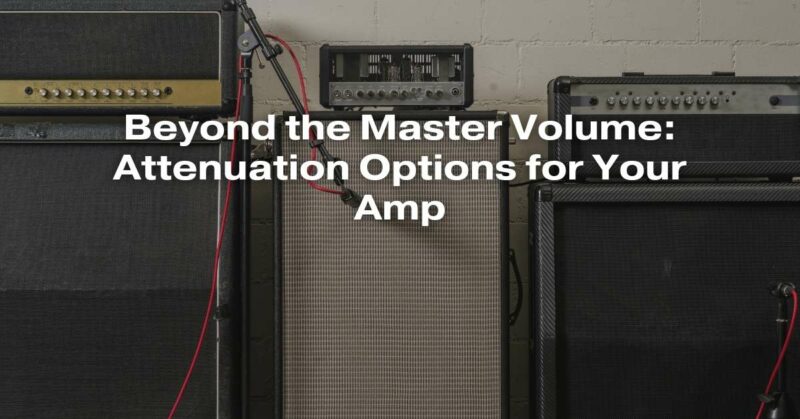When it comes to the world of electric guitar amplifiers, the quest for that perfect tone can be an ongoing journey. Many guitarists spend years experimenting with various amps, pedals, and guitars to find their unique sound. However, one aspect of the amplification process that often gets overlooked is volume control. Amps can sound incredible when cranked up to their full potential, but the sheer loudness can be impractical for many situations. This is where attenuation options come into play. In this article, we’ll explore the world of amp attenuation, its different options, and how it can be a game-changer for your sound.
The Need for Amp Attenuation
Amplifiers are designed to amplify the signal from your guitar and project it through a speaker. The louder you play, the more your amp’s tubes or transistors work, resulting in a richer and often more distorted sound. While this can be fantastic for live performances or recording sessions, it’s not always practical or neighbor-friendly to crank up your amp to its full potential.
Here are some common scenarios where you might need amp attenuation:
- Home Practice: When practicing at home, you may not want to disturb your family, roommates, or neighbors with thunderous volumes. An attenuator allows you to achieve your desired tone at lower, more manageable levels.
- Recording: In a studio environment, excessive volume can bleed into microphone recordings, making it challenging to capture clean guitar tracks. Attenuators help maintain tone while reducing volume for better recording conditions.
- Live Sound: In some gig situations, venues may have strict volume limits. An attenuator can help you achieve your preferred tone without exceeding those limits.
- Tonal Flexibility: Not all amplifiers sound their best at low volumes. Attenuators let you push your amp into its sweet spot without making your ears bleed.
Types of Attenuation
There are several methods of attenuating your amplifier’s volume, each with its own pros and cons. Here are some of the most common options:
- Built-in Attenuation: Some modern amplifiers come with built-in attenuation features. These amps often have multiple wattage settings or built-in power scaling, allowing you to reduce the output power while retaining tone and dynamics. The advantage is that it’s designed specifically for the amp, but it may not offer as much versatility as standalone attenuators.
- Resistive Attenuators: Resistive attenuators, also known as power soaks or attenuator boxes, are external devices that sit between your amplifier’s speaker output and speaker. They use resistors to dissipate excess power as heat, allowing you to lower the volume without changing the tone significantly. Popular options include the Weber MiniMass and the THD Hot Plate.
- Reactive Attenuators: Reactive attenuators, such as the UA OX Box and the Two Notes Torpedo Captor, are more advanced than resistive models. They replicate the impedance curve of a speaker, which can provide a more authentic tone at lower volumes. This option is favored by many professional guitarists for its tone preservation.
- Load Boxes and Cab Simulators: Load boxes, like the Suhr Reactive Load or Kemper Profiling Amp, allow you to disconnect your amp’s speaker completely, running it silently. You can then use cab simulators or modelers to capture the amp’s sound directly. This method is popular for silent recording and live performance.
Tips for Using Attenuators
Now that you’re familiar with the types of attenuation options available, here are some tips for effectively using them:
- Experiment: Different attenuators can produce varying results with your specific amplifier. Experiment with different models to find the one that best suits your tonal preferences.
- Speaker Matching: Make sure your attenuator’s impedance matches your amplifier and speaker. Mismatched impedances can lead to tonal issues and damage your equipment.
- Volume Management: While attenuators can reduce volume, it’s essential to find the right balance. Lowering the volume too much can result in a loss of dynamics and responsiveness.
- Tone Tweaking: Some attenuators offer EQ or tone-shaping options. Use these features to fine-tune your sound and compensate for any tonal changes caused by attenuation.
- Consider Recording Simultaneously: If you’re using a load box and cab simulator for recording, consider capturing both the dry and processed signals. This gives you flexibility during the mixing stage.
Conclusion
Attenuation options for your amplifier provide a valuable tool for achieving your desired guitar tone at manageable volumes. Whether you’re practicing at home, recording in the studio, or performing on stage, the right attenuation method can help you unlock the full potential of your amplifier without deafening yourself or your audience. Remember to experiment, match impedance correctly, and fine-tune your settings to make the most of your attenuator and elevate your guitar sound to new heights.


